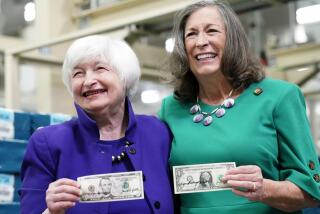Opinion: Sorry, Harriet Tubman fans, paper money isn’t what it used to be
Secretary of the Treasury Jacob Lew announced Wednesday that the front side of $20 bills produced in the future will bear the image of Harriet Tubman, the abolitionist who helped hundreds of slaves escape on the Underground Railroad.
Tubman will replace President Andrew Jackson, a slave owner, adding a note of poetic justice to the substitution.
But wait; there’s more.
Leaders of the women’s suffrage movement will be featured on the flip side of the $10 bill (whose front side will continue to bear the image of Alexander Hamilton) and the back side of the $5 bill eventually will depict, among others, Marian Anderson, the African American opera singer, and First Lady Eleanor Roosevelt.
By including women and non-politicians, the Treasury is adopting the more catholic approach to currency commemoration I advocated in a 2013 piece. (You can read it here.)
But there is a shadow over Wednesday’s announcement: The Treasury’s belated gesture toward diversity comes at a time when paper money is declining in popularity.
In 2011, the New York Times published a story headlined “As Plastic Reigns, the Treasury Slows Its Printing Presses.” A restaurateur quoted in the story revealed (to the reporter’s seeming amazement) that “I bought a gallon of milk for $2.50 at a Mobil station, and I paid with my credit card.”
Five years later, I regularly stew in the convenience-store checkout line while other customers pay for absurdly small purchases using a credit or debit card. Then there are applications that allow you to make a payment with your smartphone. By one estimate, cash is used in only half of the payments for goods and services in the U.S., compared with 80% half a century ago.
Paper money won’t disappear immediately, obviously. And in certain sectors of the economy — drug-dealing and international arms trafficking, for example — cash will remain the preferred form of exchange. But clearly paper money isn’t the common currency that it used to be.
Perhaps those who lobbied for a woman on the $10 or $20 bill should now demand that banks issue credit cards with holograms of famous female Americans.
Follow Michael McGough on Twitter @MichaelMcGough3
More to Read
A cure for the common opinion
Get thought-provoking perspectives with our weekly newsletter.
You may occasionally receive promotional content from the Los Angeles Times.











